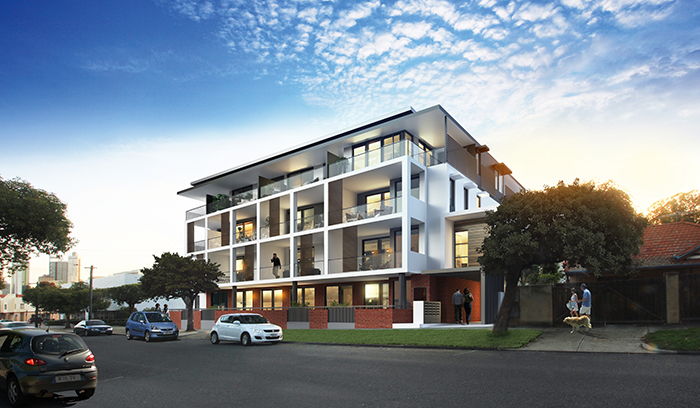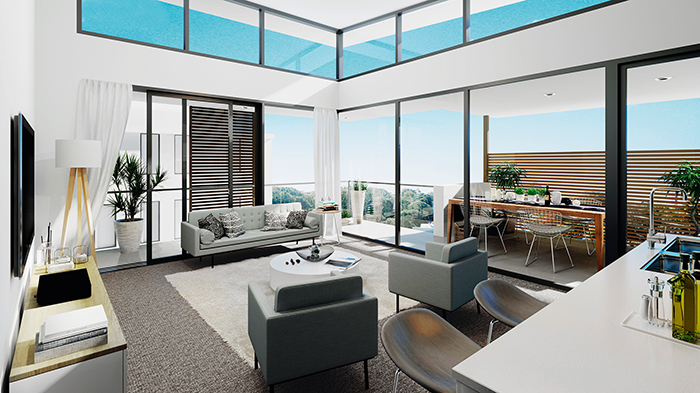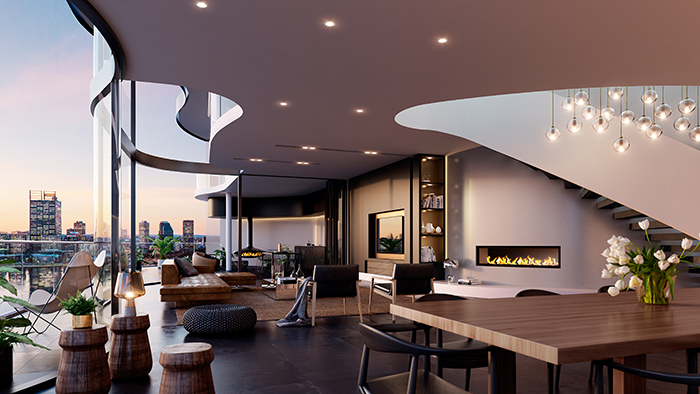The lifestyle in WA is changing, with new owners, families and baby boomers opting to live the high life in apartments. But what’s driving the change, and what does it mean for the traditional homeowner?
The quarter-acre block –for generations it's been the great Australian dream, the benchmark for home ownership to which everyone aspired. But times are changing: these days more and more people are swapping out the white picket fence for a balcony with a view. Increasingly, apartment living is becoming synonymous with modern urban life.
"Apartment living is becoming part of the norm, with buyers recognising that an apartment in or near the city puts them closer to their work and closer to the amenities they enjoy," says QUBE Property managing director Mark Hector. "It also gives them a vibrant 'inner-city' lifestyle."
Mark says that for those taking their first steps on the property ladder, an apartment can offer an affordable entry into the property market, enabling them finally to secure a home of their own. For older homebuyers, the attraction is different, but no less appealing.
"As they move towards retirement, Perth's baby boomers are recognising the benefits of downsizing into a well-located apartment – often in the same neighbourhood as the family home," explains Mark. "These active retirees
are enjoying a low-maintenance home while releasing equity that they can put towards their retirement adventures."
It's also becoming common for couples and families to seek apartments, say JCY Architects directors Ian Hart and Andrew Rogerson, the lower cost of purchase and reduced maintenance requirements allowing the occupants to spend more
time and money on lifestyle activities.
"Good-quality apartment design will offer an alternative to the traditional freestanding house," says Ian.

M/24 apartments in Leederville, by Match.
While home ownership rates have thinned nationally in recent years – with people in the 25 to 35 year-old age bracket representing a 10 per cent decrease in ownership since 1996 – owning a home is still very much a goal for many West Australians. It's just that what that home looks like is evolving: this buying group is now looking for an alternative to the house-and-land offering, and has found the answer in high-rise/high-density living.
"I don't think we should consider apartments as replacing the single detached home as the Aussie dream," explains Ian, "but rather as an alternative option for owning your own home."
Indeed, recent research by Cordell Information shows project activity at a national level for new flats and units is currently experiencing one of its biggest booms in modern times. The category represents the most substantial increase in all construction classes, with a 32 per cent increase in new projects reported between the first quarter of 2014 and the first quarter of 2015.
"The dream of home ownership is strong, and the key issue is about providing a greater choice of housing typologies that appeal to different purchasers," says Andrew. "There is such a great diversity of purchaser types – singles, couples, single-parent families, parents with kids (one, two, three or more), first-home buyers, empty nesters, downsizers, aged, investors and so on – that we need to provide a far greater choice of properties than the single detached home."
Both Ian and Andrew say they notice distinct markets, with each having differing requirements. "A large number of apartments is being designed for the investor market (intended for renters and students), while others are more for owner-occupiers," says Andrew. "The latter variety of apartments tends to be better located, with larger footprints and better amenity."
To Ian, these apartment models tend to offer a real alternative to the quarter-acre block, as well as providing lifestyle benefits such as shared amenities and proximity to town centres, or entertainment areas for occupants.
ON THE MARKET
While Western Australia is tackling the repercussions of a mining and commodity bust, the state saw a seven per cent increase in new apartment construction between 2014 and 2015, with a 24 per cent value increase, according to research by Cordell Information.
Lloyd Clark is managing director of M/Group, parent company of apartment brand Match. He says there is – and will continue to be – strong demand for apartment living. "However, with the influx of off-shore developer interest and large-scale apartment approvals, what is on offer is distinctly different.
Large-scale, high-density projects represent a completely different proposition to a well-placed boutique product that is specifically designed for the local market."
According to QUBE's Mark Hector, Perth is currently a value proposition for investors, with a competitive median apartment price of $435,000 (REIWA, December 2015), compared to $675,000 in Sydney (CoreLogic RP Data, November 2015) and $537,500 in Melbourne (REIV, December 2015).
"The argument is also supported when you compare the Perth median dwelling price of $499,000 to $810,000 in Sydney and $602,500 in Melbourne," he says (figures taken from RP Data Core Logic, November 2015).
The Perth apartment market went through a period of rapid development between 2013 and 2015, Mark explains, with a significant number of projects coming to the market to meet the growing trend towards apartment living. Demand slowed in the latter part of 2015, however, reflecting Perth's wider property market as the mining boom wound down.
"But with a significant number of projects under construction or seeking pre-sales in Perth, there are opportunities for astute investors to buy into well-located developments during the lull, with a view to capitalising on future growth," says Mark, adding that QUBE is confident that apartment living is now a normal part of the Perth property offering and demand will continue to grow into the future.
"Buyers should focus on projects that are either under construction or that have significant pre-sales, because not all the projects currently proposed will achieve the pre-sales needed to go ahead in the current market."

QUBE's Sentral Apartments will be within walking distance of ameneties in Highgate and Mt Lawley.
HIGHER DENSITY A NECESSITY
There's no doubt apartment living has its own unique appeal in terms of convenience and a low-maintenance lifestyle, but a large part of this paradigm shift towards higher density living in Perth was driven by necessity.
Perth has a long way to go in balancing its residential market. According to Ian Hart and Andrew Rogerson, approximately 90 per cent of our housing stock is in the form of detached homes, townhouses or grouped dwellings… yet more than 50 per cent of Perth households consist of two people or fewer.
The substantial increase in apartment construction is also driven by a finite, ever-decreasing amount of land near major metropolitan hubs, coupled with the fact that single-dwelling prices are going through the roof.
"For many people, apartment living offers an alternative to the long commute
to work that has been caused by Perth's urban sprawl," says Mark. "Fortunately, there are significant opportunities for infill development across Perth to help reduce urban sprawl and the rate at which it is occurring."
Mark says one of the added benefits of increased density is that it supports the growth of the surrounding amenity – including public transport – by providing
a ready customer base.
By increasing density, says Lloyd, Perth is taking a leaf out of the books of some of the world's most famous cities. "New York, Barcelona and Paris are renowned for an energy that can only be created through density and constant activity," he says. "Life creates life, and this is already evident in some of Perth's inner-city environments, including Mt Lawley and Fremantle."

An example of the interiors that will feature in QUBE's Sentral project.
SUBURBS TO WATCH
Multiple new developments are being finalised in Perth, or are under construction throughout the city and surrounds.
"Some of the traditional apartment hotspots, such as the Perth CBD, Subiaco, East Perth and South Perth, are seeing significant activity," says Mark. "Development is also booming around activity centres such as Beaufort Street
in the Mt Lawley/Highgate area, and in new transport and activity centres such
as Cockburn Central." There is also a decent level of development occurring in Scarborough, according to Mark, because the State Government is investing in infrastructure. "Rivervale, north of Crown Perth, has also experienced significant apartment growth, with developments capitalising on the area's proximity to the city, the airport, the new Perth Stadium and the entertainment hub."
Lloyd, meanwhile, says the bulk of development activity is taking place east of Perth's CBD, with large towers in the pipeline. For M/Group, however, this is seen as a risky place to invest.

JCY's Fitzgerald Street apartments in Perth (photography Damien Hatton).
"To us, key hot spots remain in established suburbs such as Fremantle, South Fremantle and the Cockburn Coast, which are currently subject to massive infrastructure investment," he says. "Subiaco is set for a revival, as are pockets around the CBD, such as West Perth, Mt Lawley, Leederville and Como."
Mark says that QUBE anticipates the next areas of activity in apartment development will be those that offer good transport links, amenity and lifestyle benefits, but that are otherwise underdeveloped. "These include Wembley town centre, where QUBE is currently constructing the 69-apartment Urban on Cambridge project, due for completion in the middle of 2016," he says.
He adds that suburban apartment development is also a growing trend, with projects such as Cockburn Central and Garden City Shopping Centre again focused on activity centres, and proximity to transport and amenity.

The penthouse in Hillam's Lumiere project, South Perth.
PERKS OF THE HIGH LIFE
Apartment living is entirely about lifestyle, and Lloyd says apartments represent low-maintenance environments often located in close proximity to great cafes, bars, parks, beaches and restaurants. "They provide security, and generally offer some of the best views in the area – outlooks that are typically out of reach to conventional homes," he explains.
Mark adds that many apartment developments offer resort-style living, with features such as a pool, gym, theatre, rooftop garden, shared activity areas
and a private dining room. "And if they're not included, they're usually right on the doorstep, which not only means you don't have to go far, but also you're only paying for those facilities that you're using," he says.
When it comes to interiors, Tom Letherbarrow, director at Hillam Architects, says buyers are becoming more educated and so expect more choice, to create properties that reflect them. "Our projects will often have three or more interior schemes," he says, "with a multitude of upgrade options that really tailor the design to the individual."
Baby boomers in particular are looking for more comforts. "They want more storage, high-end finishing, larger room sizes and generous outdoor living," says Tom. "Some of the larger, high-end apartments we design are comparable to the houses couples are leaving, but with better views and more modern conveniences."
Tom says there is also the trend towards smart technology. "You swipe a key fob at an apartment elevator that speeds you to your floor, your smartphone sends an alert your package has arrived, then you head to the fitness centre where internet-connected equipment tracks your workouts."

Hillam's Arthouse development in Joondalup.
DESIGN OF THE TIMES
In terms of style of architecture and design, Tom says Perth buyers aren't necessarily after a New York loft or a minimalist and modern European apartment.
"We like to think that Perth is becoming more design-focused," he says. "There is a lot of product out there, and we strive to bring individuality to our contemporary design approach."
Ian and Andrew agree that the Perth market prefers "substance over style".
"A well-designed contemporary apartment block featuring good environmental design, good amenity, plentiful storage, plus excellent access to outdoor balconies and shared spaces will always provide for a better lifestyle than a block designed to fit the latest 'style'," Ian says.
"We understand that what matters most to purchasers is not style, but the number of bedrooms the apartment has, safety, and proximity to family and friends," says Andrew.
Both advocate a clean and simple layout with good attention to detail, maximised lights, open-plan spaces, a strong indoor/outdoor relationship, innovative storage solutions and apartment-appropriate furniture.
"Choosing the right furniture is very important in terms of making the space feel open and not cluttered," says Tom. "Make sure that you measure out the pieces you have, or intend to purchase, while in plan, so you can ensure they fit the space correctly and there is adequate circulation around the pieces."
Tom says savvy storage solutions hide away items that are used infrequently, making the space feel more open and airy. "Pay particular attention to furniture pieces that have inbuilt storage solutions, for example beds with drawers built-in underneath," he says.
"Keeping the interiors generally quite light will help open the space, but don't forget to contrast with some darker colours so you achieve a dynamic interior."

The exterior of Hillam's Lumiere development in South Perth.
HIGH CONCEPT
Architect Brad Swartz, winner of the 2015 Houses Award for Best Apartment or Unit, shares his thoughts on getting the best from apartment design.
Maximise your space
Whenever I approach the design of a space, the first thing I'm thinking about is how to use the natural light and views to maximise the feeling of space. The brighter and lighter the space, the larger it tends to feel. To make the most of natural light, I'm careful to keep the design as open as possible around the windows. For example, in a recent project, we removed the walls to a small kitchen, which meant the light from the kitchen window could then be shared with the living/dining area. Another example of a way to increase the feeling of space is through the controlled use of mirrors, which subtly make the space feel larger.
Create a sense of calm
I then look to achieve the client's brief through a contemporary design style
to create a sense of calmness in the space. This is achieved through clean lines,
and designing a place for everything to go.
Get professional advice
Each apartment is unique, so the best way to fit out the interior of an apartment will also be unique. A professional will approach a project with knowledge and experience to get the most out of a fitout. Use an architect or interior architect/designer whose architectural style you like. Visit bradswartz.com.au.
CONTACTS
Hillam Architects hillam.com.au
JCY Architects jcy.net
M/Group (Match) mgroup.com.au
QUBE Property qubeproperty.com.au